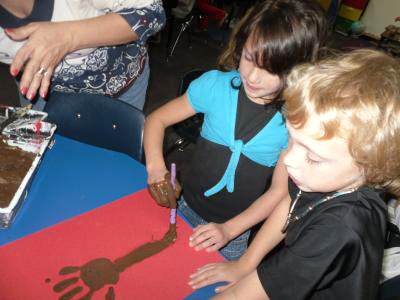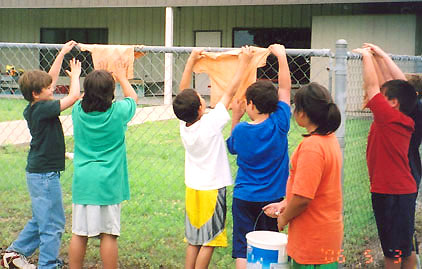Soil Science
"The nation that destroys its soil destroys itself."
- Franklin D. Roosevelt
When you dig into the ground under the grass in your yard, you will find soil. But what happens if you keep on digging? If you dug far enough, would you run out of soil? How far would you have to dig before you ran out? And what would you find there?
If you dug far enough, you would hit solid rock. This is called bedrock. But before you got there you would have to dig though three different layers of soil. The layers are known as horizons, and all the layers together make up the soil profile. The first layer would be nothing but dark-colored organic materials. That is the layer formed by plants and insects that have died and dead leaves that have fallen. Just under that is the topsoil. The topsoil is the best place for plants to take root and grow. It is a mixture of air, water, organic material (matter from dead plants and animals) and minerals (sand, clay, silt).
In most places the topsoil is between six and 20 inches thick. The subsoil is the layer below the topsoil. It is made mostly of clay or sand and has very little organic material. Plants have a hard time growing in subsoil. Between the subsoil and the bedrock are a layer of small rocks that have started to break off the bedrock. This layer is the parent material of the soil. That's because most of what makes up the soil was once part of the rock.
Soil covers much of the land on Earth. It provides a substrate for plants (Roots anchor in soil.), a source of food for plants, and a home for many animals (insects, spiders, centipedes, worms, burrowing animals, bacteria, and many others). Soils are home to two or more tons of living things per acre. Microflora, insects, worms and animals, as well as other organisms, produce acids that, in turn, help break down soil minerals. Organic matter is beneficial to soils. It increases water-holding capacity, serves as a reservoir for plant nutrients such as nitrogen, and provides food for the living things in the soil.
Minerals have several different ways of getting into the soil. Sometimes they come from the ashes of volcanoes that have erupted. Usually the minerals come from rocks that have been broken apart. Water from rain flows into the cracks of rocks. When the water freezes, it expands and causes the cracks in the rocks to get bigger and little bits of rock break off. Sometimes the roots of trees and deep-rooted plants grow into the rocks and draw the minerals up through the roots and into the plant. The minerals become part of the leaves that later fall to the ground. Many rocks are broken apart by lichens — tiny plants that live on rocks. Sometimes water just keeps running over the rock until tiny particles start to wash away. We call all these processes "weathering." Water and wind carry the tiny bits of rock along until they get trapped by the soil. It can take hundreds of years for rocks to break into pieces that are small enough to form soil. It takes between 200 and 500 years for just one inch of topsoil to form.
Clay, Silt, Sand
There are three basic categories of particles that exist in soils. Clay is the smallest, feels sticky and often stains the fingers. Silt feels smooth and soft and is somewhat slick. Clay and silt particles cannot be seen with the naked eye. Sand particles can be seen with the naked eye. They are the largest and feel gritty.
Soils are distinguished by observing the percentage of each of the three types of particles. These mixtures are called loams. If soil has more sand it is a "sandy loam," more silt, a "silty loam," or more clay, a "clay loam." Soils vary in their ability to be cultivated. The combination of particle types dictates how the soil will handle, drain and hold water.
Clay loams hold water tightly, but they drain poorly. Clayish soils are sticky. Plants growing in clay may suffer from a lack of air around the roots because the tiny clay particles absorb so much water. Clay soils drain poorly and prevent plants from getting the needed water around their roots.
Sandy loams provide enough air to the roots because the particles are large; however, sand does not hold water well, and it drains quickly. The water becomes unavailable to thirsty plants. Plants in sand soils need to be watered frequently.
Silty loams can be found around water sources. It is generally the soil that is carried in by flooding and then left in the drying process. This soil can collect organic materials and nutrients and store them in the existing soil.
The best growing soils combine the airiness and drainage of sand with the water-holding capacity of clay. Loam soils that contain approximately 40 percent sand, 40 percent silt and 20 percent clay are considered the best cultivating soils.
Soil Formation
"The crust of the earth is a vast museum."
-Charles Darwin
Soil formation is influenced by five factors: geology (parent material), topography, climate, plants and animals (organic material), and time. These factors give soil profiles their distinctive character. Color, texture, size and shape of soil aggregates, kind and amount of rock fragments, distribution of plant roots, pH, and other features are used to characterize soils. After a soil is described and its properties are determined, soil scientists assign the soil to one of 12 taxonomic orders and/or one of many suborders.
The Natural Resources Conservation Service (NRCS) has identified and mapped over 20,000 different kinds of soil in the United States. They come in a wonderful range of hues, from black to yellow to deep red.
In Oklahoma, there are over 2,500 different kinds of soil—more different varieties than just about any area this size on earth. We have a variable climate and many different kinds of geologic materials across the state. These factors influence the formation of different kinds of soil. Our state is well known for our red soil, caused by the large amount of iron in the soil, but no one individual soil occurs throughout every region of the state.
Port silt loam, our state soil, is the most common soil in Oklahoma and is present in at least 33 counties. It is very productive and is used to grow a wide range of crops—cotton, wheat, sorghums, oats and others. Port silt loam is dark brown to dark reddish brown and is derived from upland soil materials weathered from reddish sandstones, siltstones and shales. The natural soil supports a native, undisturbed vegetation of tall prairie grasses and native trees, including pecan, walnut, bur oak and cottonwood.
Sources: "Port Silt Loam: Oklahoma's State Soil," Oklahoma Conservation Commission pamphlet; "Discovering Dirt," AIMS Education Foundation, 1987; Dirt: Secrets in the Soil, Utah Foundation for Agriculture in the Classroom
Soil Erosion
Soil erosion is what happens when soil is washed or blown away. The slope of the land, the climate and the texture of the soil all play a part. In places where the land is covered with plants such as grass or trees, erosion takes place so gradually that the new soil is formed before erosion has time to occur.
That is not the case in places where the soil has little or no plant cover. The Grand Canyon is a very familiar example of erosion by water. Most of the erosion there was the work of nature rather than humans. In that part of the country the hot, dry climate makes it difficult for plants to grow. The soil is sandy. Sand particles don't stick together very well, so they wash away easily. The land around the Grand Canyon slopes into the Colorado river, and that also makes erosion more likely.
Heavy rains cause soils to erode away in many parts of Oklahoma where the land slopes and the soil is unprotected. One of the best examples of wind erosion in Oklahoma is the Little Sahara State Park in Major County. Windy conditions, sandy soils and sparse vegetation are the cause of the erosion there.
Keeping soil healthy is very important to farmers. For that reason, careful farmers do their best to protect their soil. The best way for farmers to do this is to keep their fields covered with vegetation at all times. Plant cover provides a cushion against the beating force of the rain and also slows the wind at the soil's surface.
Some farmers protect their soil by leaving stubble or residue in their fields after they have harvested their crops. Other farmers plant their fields with grass or cover crops during seasons when they are not growing their main crop. Alfalfa, clover and field peas send roots deep into the soil and help hold it in place. Those crops also fix nitrogen from the air and make it available to the soil. When it is time to plant, the farmer will turn the stubble or cover crops under to add extra organic matter to the soil. The organic matter, in turn, helps the soil hold together and soak up moisture rather than wash away.
 Muddy Trees, activity from Dirty Pictures
Muddy Trees, activity from Dirty Pictures


 Oklahoma Dirt Shirt
Oklahoma Dirt Shirt